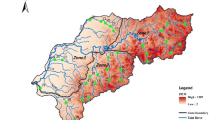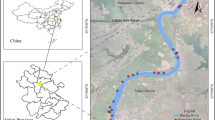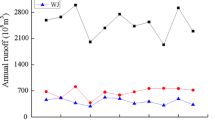Abstract
The Beiyun river flows through a hot spot region of Beijing-Tianjin-Hebei in China that serves a majority of occupants. However, the region experiences severe nitrate pollution, posing a threat to human health due to inadequate self-purification capacity. In that context, there is an urgent need to assess nitrate levels in this region. Herein, we used δ15N-NO3, δ18O-NO3 isotopes analysis, and stable isotope analysis model to evaluate the nitrate source apportionment in the Beiyun river. A meta-analysis was then used to compare the potential similarity of nitrate sources among the Beiyun riverine watershed and other watersheds. Results of nitrate source apportionment revealed that nitrate originated from the manure and sewage (contribution rate: 89.6%), soil nitrogen (5.9%), and nitrogen fertilizer (3.9%) in the wet season. While in the dry season, nitrate mainly originated from manure and sewage (91.6%). Furthermore, different land-use types exhibited distinct nitrate compositions. Nitrate in urban and suburban areas mostly was traced from manure and sewage (90.5% and 78.8%, respectively). Notably, the different nitrate contribution in the rural-urban fringe and plant-covered areas were manure and sewage (44.3% and 32.8%), soil nitrogen (26.9% and 35.7%), nitrogen fertilizer (23.5% and 29.4%), and atmospheric deposition (5.3% and 2.0%). Through a meta-analysis, we found nitrogen fertilizer, soil nitrogen, and manure and sewage as the main nitrate sources in the Beiyun riverine watershed or the other similar complexed watersheds in the temperate regions. Thus, this study provides a scientific basis for nitrate source apportionment and nitrate pollution preventive management in watersheds with complexed land-use types in temperate regions.







Similar content being viewed by others
Data availability
All data is provided in full in the results section of this manuscript.
References
Archana A, Thibodeau B, Geeraert N, Xu M, Kao S, Baker D (2018) Nitrogen sources and cycling revealed by dual isotopes of nitrate in a complex urbanized environment. Water Res 142:459–470
Bu H, Song X, Zhang Y, Meng W (2017) Sources and fate of nitrate in the Haicheng River basin in Northeast China using stable isotopes of nitrate. Ecol Eng 98:105–113
Ding J, Xi B, Gao R, He L, Liu H, Dai X, Yu Y (2014) Identifying diffused nitrate sources in a stream in an agricultural field using a dual isotopic approach. Sci Total Environ 484:10–18
Divers M, Elliott E, Bain D (2013) Constraining nitrogen inputs to urban streams from leaking sewers using inverse modeling: Implications for dissolved inorganic nitrogen (DIN) retention in urban environments. Environ Sci Technol 47(4):1816–1823
Divers M, Elliott E, Bain D (2014) Quantification of nitrate sources to an urban stream using dual nitrate isotopes. Environ Sci Technol 48(18):10580–10587
Fadhullah W, Yaccob N, Syakir M, Muhammad S, Yue F, Li S (2020) Nitrate sources and processes in the surface water of a tropical reservoir by stable isotopes and mixing model. Sci Total Environ 700:134517
Hale R, Turnbull L, Earl S, Grimm N, Riha K, Michalski G, Lohse K, Childers D (2014) Sources and transport of nitrogen in arid urban watersheds. Environ Sci Technol 48(11):6211–6219
Hu M, Liu Y, Zhang Y, Dahlgren R, Chen D (2019) Coupling stable isotopes and water chemistry to assess the role of hydrological and biogeochemical processes on riverine nitrogen sources. Water Res 150:418–430
Jackson A, Inger R, Bearhop S, Parnell A (2009) Erroneous behaviour of MixSIR, a recently published Bayesian isotope mixing model: a discussion of Moore & Semmens. Ecol Lett 12(3):1–5
Jani J, Toor G (2018) Composition, sources, and bioavailability of nitrogen in a longitudinal gradient from freshwater to estuarine waters. Water Res 137:344–354
Jiang H, Zhang QQ, Liu WJ, Zhang JY, Pan K, Zhao T, Xu ZF (2021) Isotopic compositions reveal the driving forces of high nitrate level in an urban river: implications for pollution control. J Clean Prod 298:126693–126703
Kruk M, Mayer B, Nightingale M, Laceby J (2020) Tracing nitrate sources with a combined isotope approach (delta(15)NNO3, delta(18)ONO3 and delta(11)B) in a large mixed-use watershed in southern Alberta, Canada. Sci Total Environ 703:135043
Li C, Jiang Y, Guo X, Cao Y, Ji H (2014a) Multi-isotope ((15)N, (18)O and (13)C) indicators of sources and fate of nitrate in the upper stream of Chaobai River, Beijing, China. Environ Sci-Process Impacts 16(11):2644–2655
Li X, Liu C, Liu X, Yu J, Liu X (2014b) Sources and processes affecting nitrate in a dam-controlled subtropical river, Southwest China. Aquat Geochem 20(5):483–500
Li C, Li S, Yue F, Liu J, Zhong J, Yan Z, Zhang R, Wang Z, Xu S (2019) Identification of sources and transformations of nitrate in the Xijiang River using nitrate isotopes and Bayesian model. Sci Total Environ 646:801–810
Liu J, Shen Z, Yan T, Yang Y (2018) Source identification and impact of landscape pattern on riverine nitrogen pollution in a typical urbanized watershed, Beijing, China. Sci Total Environ 628–629:1296–1307
Liu Y, Wang X, Wen Q, Zhu N (2019) Identifying sources and variations of organic matter in an urban river in Beijing, China using stable isotope analysis. Ecol Ind 102:783–790
Lu L, Cheng H, Pu X, Liu X, Cheng Q (2015) Nitrate behaviors and source apportionment in an aquatic system from a watershed with intensive agricultural activities. Environ Sci-Process Impacts 17(1):131–144
Ma G, Wang Y, Bao X, Hu Y, Liu Y, He L, Wang T, Meng F (2015) Nitrogen pollution characteristics and source analysis using the stable isotope tracing method in Ashi River, northeast China. Environ Earth Sci 73(8):4831–4839
Ma P, Liu S, Yu Q, Li X, Han X (2019) Sources and transformations of anthropogenic nitrogen in the highly disturbed Huai River Basin, Eastern China. Environ Sci Pollut Res 26(11):11153–11169
Peters M, Guo Q, Strauss H, Wei R, Li S, Yue F (2019) Contamination patterns in river water from rural Beijing: a hydrochemical and multiple stable isotope study. Sci Total Environ 654:226–236
Roguet A, Eren AM, Newton RJ, Mclellan SL (2018) Fecal source identification using random forest. Microbiome 6(1):185
Shin W, Ryu J, Lee K, Chung G (2013) Seasonal and spatial variations in water chemistry and nitrate sources in six major Korean rivers. Environ Earth Sci 68(8):2271–2279
Silva S, Kendall C, Wilkison D, Ziegler A, Chang C, Avanzino R (2000) A new method for collection of nitrate from fresh water and the analysis of nitrogen and oxygen isotope ratios. J Hydrol 228(1):22–36
Wang ZJ, Xu MM, Wang YH, Wang T, Wu N, Zheng WJ, Duan HW (2021) Air particulate matter pollution and circulating surfactant protein: a systemic review and meta-analysis. Chemosphere 272:129564–129572
Wu W, Liao R, Hu Y, Wang H, Liu H, Yin S (2020) Quantitative assessment of groundwater pollution risk in reclaimed water irrigation areas of northern China. Environ Pollut 261:114173
Xian C, Ouyang Z, Li Y, Xiao Y, Ren Y (2016) Variation in nitrate isotopic signatures in sewage for source apportionment with urbanization: a case study in Beijing, China. Environ Sci Pollut Res 23(22):22871–22881
Xing M, Liu W (2011) An improved method of ion exchange for nitrogen isotope analysis of water nitrate. Anal Chim Acta 686(1–2):107–114
Xue D, De Baets B, Van Cleemput O, Hennessy C, Berglund M, Boeckx P (2012) Use of a Bayesian isotope mixing model to estimate proportional contributions of multiple nitrate sources in surface water. Environmental Pollut 161:43–49
Yang Y, Toor GS (2016) delta(15)N and delta(18)O reveal the sources of nitrate-nitrogen in urban residential stormwater runoff. Environ Sci Technol 50(6):2881–2889
Yi Q, Chen Q, Hu L, Shi W (2017) Tracking nitrogen sources, transformation, and transport at a basin scale with complex plain river networks. Environ Sci Technol 51(10):5396–5403
Zhang Q, Wang X, Sun F, Sun J, Liu J, Ouyang Z (2015) Assessment of temporal and spatial differences of source apportionment of nitrate in an urban river in China, using delta(15)N and delta(18)O values and an isotope mixing model. Environ Sci Pollut Res 22(24):20226–20233
Zhang Y, Shi P, Li F, Wei A, Song J, Ma J (2018) Quantification of nitrate sources and fates in rivers in an irrigated agricultural area using environmental isotopes and a Bayesian isotope mixing model. Chemosphere 208:493–501
Zhang C, Wan Z, Jing Z, Zhang S, Zhao Y (2020) Calculation of ecological water requirements of urban rivers using a hydrological model: a case study of Beiyun River. J Clean Prod 262:121368
Zhang L, You Y, Gao C, Peng Y, Cao Z (2021) Dissolved organic nitrogen structural and component changes in overlying water along urban river at molecular and material levels - Beiyun basin case study. J Clean Prod 287:125570
Funding
This work was financially supported by the Major Science and Technology Program for Water Pollution Control and Treatment (No. 2018ZX07111003) and the National Natural Science Foundation of China (No. 41977142).
Author information
Authors and Affiliations
Contributions
Zuhong Lin: experiment, software, writing-original draft preparation. Junchi Liu: experiment, data curation, editing. Yong Xiao: funding acquisition, supervision. Chaojie Yu: experiment, software. Jinlan Zhang: experiment. Tingting Zhang: funding acquisition, writing-review and editing.
Corresponding authors
Ethics declarations
Competing interests
The authors declare no competing interests.
Additional information
Responsible Editor: Xianliang Yi
Publisher's note
Springer Nature remains neutral with regard to jurisdictional claims in published maps and institutional affiliations.
Supplementary Information
Below is the link to the electronic supplementary material.
Rights and permissions
About this article
Cite this article
Lin, Z., Liu, J., Xiao, Y. et al. Contribution of nitrogen sources to streams in mixed-use watershed varies seasonally in a temperate region. Environ Sci Pollut Res 29, 20357–20369 (2022). https://doi.org/10.1007/s11356-021-16930-8
Received:
Accepted:
Published:
Issue Date:
DOI: https://doi.org/10.1007/s11356-021-16930-8




